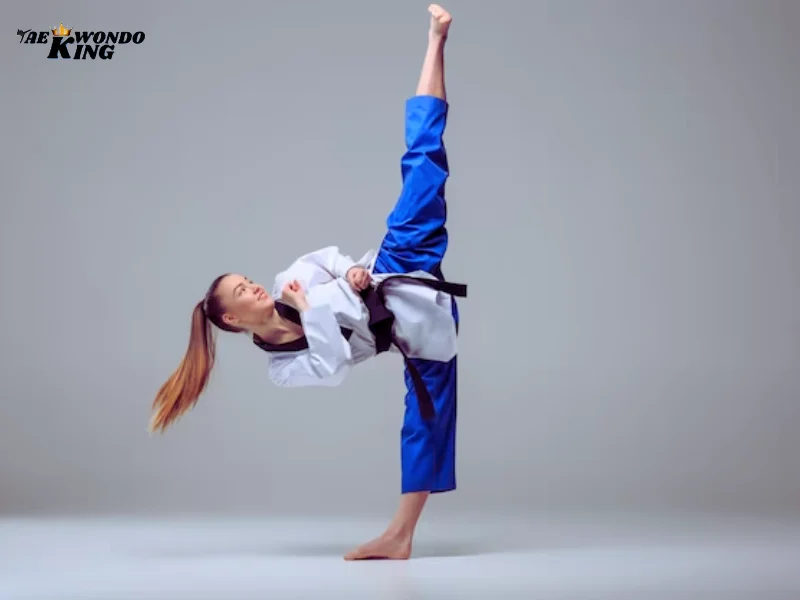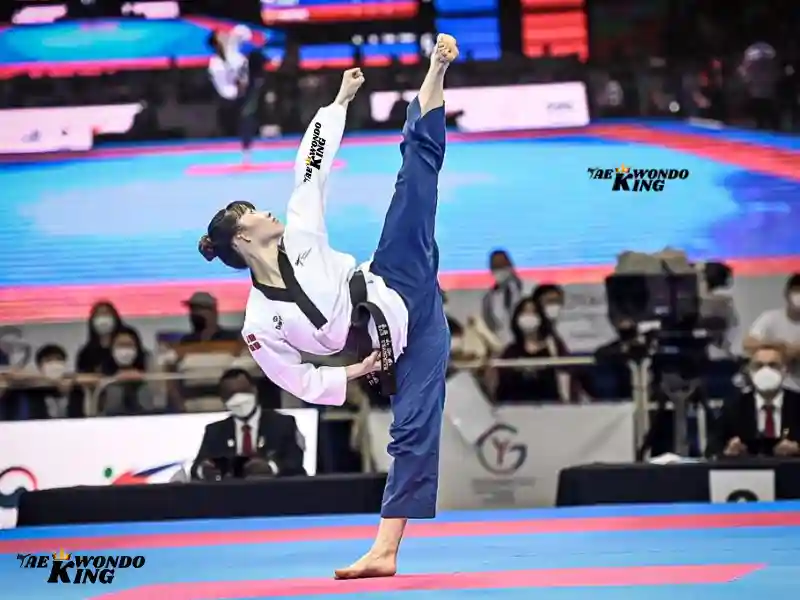
I first heard a Poomsae name shouted across the dojang. I was confused but curious, it sounded more like a spell than a Taekwondo term! Over time, I learned that each Poomsae carries deep meaning, shaped by history, philosophy, and the journey of the martial artist. As a coach and competitor, I’ve guided many students through these forms, helping them understand more than just the moves.
In this article, we’ll break down what each Poomsae name stands for and why it matters. Stick around, this could change how you see your next training session!
Get updates by joining Taekwondoking’s official WhatsApp channel.
Check out the latest prize in Taekwondo equipment Today.

What is Taekwondo Poomsae?

Taekwondo Poomsae refers to a set sequence of movements or patterns, performed in a systematic and predetermined manner. Poomsae is an integral aspect of Taekwondo training, emphasizing the application of various techniques, stances, and combinations in a disciplined and controlled manner. These patterns are designed to simulate different combat scenarios, allowing practitioners to demonstrate their understanding of Taekwondo techniques, balance, and focus.
Each Poomsae has a specific name and consists of a series of movements, including blocks, strikes, and kicks. Poomsae practice helps practitioners improve their precision, form, and overall martial arts skills. There are different Poomsae for various belt levels, and practitioners progress to more complex forms as they advance in rank.
Poomsae is not only a physical exercise but also a means of expressing the philosophical and spiritual aspects of Taekwondo. It encourages mental focus, discipline, and the application of martial principles. Learning and mastering Poomsae is an essential component of a Taekwondo practitioner’s journey towards proficiency and understanding of the art.
Check out the latest prize in Taekwondo equipment on Amazon.
How many types of Poomsae are there in Taekwondo?

The number of Poomsae in Taekwondo can vary depending on the specific style or school of Taekwondo. However, the World Taekwondo (WT) and the Kukkiwon, the World Taekwondo Headquarters, have established a standardized set of Poomsae for practitioners. As of my last knowledge update in January 2022, there are eight recognized Taekwondo Poomsae (also known as Taegeuk or Palgwe):
- Taegeuk Il Jang (1st Poomsae)
- Taegeuk Ee Jang (2nd Poomsae)
- Taegeuk Sam Jang (3rd Poomsae)
- Taegeuk Sa Jang (4th Poomsae)
- Taegeuk O Jang (5th Poomsae)
- Taegeuk Yuk Jang (6th Poomsae)
- Taegeuk Chil Jang (7th Poomsae)
- Taegeuk Pal Jang (8th Poomsae)
These Poomsae are part of the standard curriculum for color belt (geup) levels. In addition to the Taegeuk Poomsae, there are also higher-level Poomsae for black belt (dan) ranks, such as the Koryo, Keumgang, Taebaek, Pyongwon, Sipjin, Jitae, Cheonkwon, and Hansu.
It’s essential to note that the specific Poomsae sequence and names may vary in different Taekwondo organizations or styles. To ensure accuracy, practitioners should refer to the guidelines provided by their specific Taekwondo governing body or school.
What is the name of Poomsae 1?
The first Poomsae in Taekwondo is called “Taegeuk Il Jang.” Each Taegeuk Poomsae is assigned a number, and “Il Jang” represents the number one. Taegeuk Il Jang is typically the first Poomsae learned by Taekwondo practitioners, especially those at the beginner or white belt level.
In Taegeuk Il Jang, practitioners perform a series of movements and techniques in a systematic and choreographed manner. The Poomsae serves as an introduction to fundamental Taekwondo stances, blocks, strikes, and kicks. As practitioners progress through their training and advance in rank, they learn additional Taegeuk Poomsae, each building on the skills acquired in the previous forms.

What does taegeuk 1 symbolize?
In Taekwondo, each Taegeuk Poomsae, including Taegeuk Il Jang (Taegeuk 1), symbolizes specific philosophical and martial principles. The Taegeuk Poomsae series is designed to represent the continuous cycle of yin and yang, the fundamental concept of opposites and balance in Korean philosophy. Here are some common interpretations of the symbolism behind Taegeuk Il Jang:
- Keon (건): Taegeuk Il Jang represents the concept of “Keon,” which symbolizes the beginning of creation. It signifies the initial stage of learning and the practitioner’s journey into the world of Taekwondo.
- The Gwae (Symbol): The trigram symbol associated with Taegeuk Il Jang represents the “Keon” principle. The trigram consists of three broken lines, symbolizing the ceaseless interaction between heaven, earth, and humanity.
- Basic Techniques: Taegeuk Il Jang introduces fundamental Taekwondo techniques, including stances, blocks, punches, and kicks. These basic movements lay the foundation for more advanced Poomsae as practitioners progress in their training.
- Balance and Harmony: The Poomsae emphasizes the importance of balance and harmony in both physical movements and mental focus. Practitioners learn to execute techniques with precision while maintaining a centered and composed posture.
- White Belt Level: Taegeuk Il Jang is often the first Poomsae learned by beginners, typically at the white belt level. It marks the beginning of a practitioner’s Taekwondo journey and sets the stage for the subsequent Taegeuk forms.
As practitioners advance through the Taegeuk Poomsae series, they delve deeper into the philosophical and technical aspects of Taekwondo, building upon the foundational principles introduced in Taegeuk Il Jang.
What is the name of Poomsae 2?

The second Poomsae in Taekwondo is called “Taegeuk Ee Jang.” Each Taegeuk Poomsae is assigned a number, and “Ee Jang” represents the number two. Taegeuk Ee Jang follows Taegeuk Il Jang in the sequence of the Taegeuk Poomsae series.
Taegeuk Ee Jang builds upon the foundational movements learned in Taegeuk Il Jang, introducing new techniques, stances, and combinations. As practitioners progress through the Taegeuk forms, they continue to enhance their skills and understanding of Taekwondo principles.
Taekwondo all poomsae is an amazing technique that is the most commonly practiced in taekwondo. A poomsae is a collection of poomse or Taekwondo forms, from Taekwondo. Each poomsae can be used by itself, as a warm-up, or for self-defense.
Taekwondo Poomsae 1-17 Names
Taekwondo All Poomsae is a unique way of naming your Taekwondo club. All Poomsae is a series of seven basic blocks that comprise the entire taekwondo repertoire. I am going to teach you Taekwondo, all the Poomsae names of my students, and I have been teaching this art for a very long time. I have many students who were my students or my students’ students.
As I started practicing taekwondo, I quickly realized that each poomsae had its own unique name, and learning them became a key part of my training. The poomsae names, from “Taegeuk Il Jang” to “Taegeuk Chil Jang,” represent different stages of progression, and each carries its own meaning. Mastering the poomsae names helped me connect with the philosophy behind the movements, making each practice session feel purposeful and more rewarding.
Taekwondo Poomsae 1-17 Names List:
- Taegeuk Il Jang – Represents the beginning of a journey, symbolizing the universe and the balance of opposites.
- Taegeuk Eui Jang – Symbolizes strength, justice, and the power to defend.
- Taegeuk Sam Jang – Represents strength and balance, emphasizing stability.
- Taegeuk Sa Jang – Symbolizes harmony and the force of an energetic will.
- Taegeuk Oh Jang – Represents power, fire, and energy, emphasizing confidence and control.
- Taegeuk Yuk Jang – Symbolizes growth, development, and the control of emotions.
- Taegeuk Chil Jang – Represents the wisdom gained through perseverance and intellectual growth.
- Taegeuk Pal Jang – Symbolizes the ultimate achievement, completeness, and the mastery of the martial art.
- Koryo – Symbolizes the power and wisdom of the ancient Korean kingdom, Koryo.
- Keumgang – Represents unshakable strength, symbolizing granite-like endurance.
- Taebaek – Symbolizes the mountain’s unwavering strength and stability.
- Pyongwon – Represents the strength and power of the Earth.
- Sipjin – Symbolizes the tenacity of a great warrior and the balance of the mind and body.
- Jitae – Represents the historical significance of justice and the importance of duty.
- Chil Sung – Symbolizes seven stars in the sky, representing inspiration and leadership.
- Imwon – Represents balance and precision, and the ability to control both mind and body.
- Eui Am – Symbolizes righteousness, justice, and the duty to uphold virtue.
Yellow Belt Poomsae Name
As a beginner, one of the most memorable moments for me was earning my yellow belt, which introduced me to the first poomsae beyond the basics. For the yellow belt, the form you learn is “Taegeuk Il Jang,” which symbolizes the beginning of a journey and represents the universe’s start. It’s a simple yet powerful form that helped me grasp the foundation of taekwondo.
Quick Answer: The yellow belt poomsae name is “Taegeuk Il Jang,” symbolizing the start of a journey in taekwondo.
Taekwondo Blue Belt Poomsae
Reaching the blue belt in taekwondo felt like a milestone. For blue belt practitioners, the poomsae “Taegeuk Sam Jang” is the focus, which symbolizes strength and balance. I remember feeling proud to learn this form because it challenged my technique and helped me develop more power in my kicks and stances.
Quick Answer: The blue belt poomsae name is “Taegeuk Sam Jang,” symbolizing strength and balance.
Red Belt Taekwondo Poomsae Name
When I advanced to red belt, I was introduced to “Taegeuk Oh Jang,” a poomsae that emphasizes power and control. This was a significant step in my taekwondo journey because it taught me how to combine speed with strength while maintaining focus. “Taegeuk Oh Jang” represents the element of fire, symbolizing energy and passion in your training.
Quick Answer: The red belt poomsae name is “Taegeuk Oh Jang,” which represents power, fire, and energy.
Some Important Information on Taekwondo Poomsae

The term taekwondo is a modern Korean martial art that blends techniques from both traditional Korean wrestling and Chinese styles of Kung Fu. Taekwondo gi, taekwondo uniform, taekwondo belts, and taekwondo ranks are essential in taekwondo classes in a taekwondo academy. It’s also an effective sport that combines strategy, technique, and endurance, all while providing a workout that anyone can enjoy. This is why it’s such a popular sport among people of all ages and fitness levels.
The taekwondo poomsae “All Poomsae” is a list of 17 poomsae, divided into eight sets (groups of 3) and one set of six. Each of the eight sets in “All Poomsae” has the same name. It is not possible to learn all the poomsae in a day (although most schools do teach them).
In this article, the names of all WTF Taegeuk Poomsae and what belt level you need to know the participants of Taekwondo.
Taegeuk All Poomsae names (8):
Poomsae 1. Taegeuk Il Jang 태극 (White Belt)
Poomsae 2. Taegeuk Yie Jang 태극 (Yellow Belt)
Poomsae 3. Taegeuk Sam Jang 태극 (Green Belt)
Poomsae 4. Taegeuk Sah Jang 태극 (Green Blue Belt)
Poomsae 5. Taegeuk Oh Jang (Blue Belt)
Poomsae 6. Taegeuk Yuk Jang (Blue Red Belt)
Poomsae 7. Taegeuk Chil Jang (Red Belt)
Poomsae 8. Taegeuk Pal Jang (Sinio Red Belt)
The names of others, WTF Poomsae name (09-17), and Belt ranks:

1. Poomsae 09: Koriyo (1st Dan/Poom Black Belt)
2. Poomsae 10: Keumgang (2nd Dan Black Belt)
3. Poomsae 11: Taebak (3rd Dan Black Belt)
4. Poomsae 12: Pyongwon (4th Dan Black Belt)
5. Poomsae 13: Sipjin (5th Dan Black Belt)
6. Poomsae 14: Jitae (6th Dan Black Belt)
7. Poomsae 15: Chonkwon (7th Dan Black Belt)
8. Poomsae 16: Hansu (8th Dan Taekwondo Black Belt)
9. Poomsae 17: Ilyo (9th Dan Taekwondo Black Belt)
In conclusion,
Taekwondo All Poomsae is a great name for a martial arts school. It’s unique and memorable. It’s a great name because it’s short and it’s also grammatically correct. Kukkiwon (widely known as the World Taekwondo Headquarters), The World Taekwondo Federation (WTF), the International Taekwon-Do Federation (ITF), and other systems (which include some persons receiving ranks from taekwondo organizations that predate the other two systems, e.g., the original Korea Taekwondo Association (KTA) and United Taekwondo Association (UWTA). TKD takes only about 3 years to become a “black belt” under traditional martial arts programs. Some kids are black belts at ages 5-7. So, when your martial arts school has a name, make sure you choose something unique, memorable, and grammatically correct. You can read the WT Poomsae ranking 2023.

FAQs
To achieve a high score in Taekwondo Poomsae competitions, here are some tips:
1. Focus on accuracy: Make sure your movements are precise and clean. Pay attention to details and perform each technique with control and correct timing.
2. Develop firm stances: Stances play a significant role in Poomsae. Work on developing strong and balanced stances, maintaining the correct posture throughout the entire routine.
3. Timing and rhythm: Practice your Poomsae routine with proper timing and rhythm. Your movements should flow smoothly, and transitions between techniques should be seamless.
4. Expression and presentation: Poomsae is not just about technique; it also involves expression and presentation. Show confidence, energy, and a strong presence while performing. Emphasize the key movements and make them stand out.
5. Practice regularly: Consistent practice is essential to improve your skills and performance. Set aside dedicated time for training and focus on mastering the techniques and sequences of your chosen Poomsae.
6. Seek feedback: Get feedback from experienced instructors or judges to identify areas for improvement. They can provide valuable insights and help you refine your performance.
7. Compete regularly: Participate in Taekwondo Poomsae competitions regularly to gain experience and exposure. Competing will help you understand the scoring criteria and improve your performance under pressure.
Remember, achieving a high score in Poomsae competitions requires dedication, hard work, and continuous improvement.
To achieve a black belt in Taekwondo Poomsae, you will need to follow a structured training program and progress through various belt levels. Here are some steps to help you on your journey:
1. Find a reputable Taekwondo school or instructor who specializes in Poomsae training.
2. Begin your training by learning and mastering the basic techniques, stances, and forms of Taekwondo.
3. Attend regular classes and practice consistently to improve your skills, flexibility, and strength.
4. Work closely with your instructor to set specific goals and track your progress.
5. Train and compete in local and national Poomsae competitions to gain experience and improve your performance.
6. As you advance through the belt levels, continue to refine your techniques, memorize and perfect each Poomsae form, and demonstrate a strong understanding of the principles and philosophy of Taekwondo.
7. Once you have reached the required level of skill and expertise, you will need to pass a black belt test conducted by a qualified Taekwondo organization or federation.
8. The black belt test typically includes a performance of various Poomsae forms, sparring, self-defense techniques, and a written exam on Taekwondo theory and history.
9. After successfully completing the test, you will be awarded a black belt and recognized as a proficient practitioner of Taekwondo Poomsae.
Remember, achieving a black belt requires dedication, hard work, and perseverance. It is a journey that takes time and commitment, so be patient and enjoy learning and improving your skills in Taekwondo.
To achieve precision and accuracy in Taekwondo Poomsae, here are some tips:
1. Practice regularly: Consistent practice is essential to improve your technique and develop muscle memory.
2. Focus on proper body alignment: Pay attention to your stance, posture, and alignment of each movement. This will help you maintain balance and execute techniques accurately.
3. Break down each movement: Analyze and break down each Poomsae movement into smaller parts. Practice these individual parts before putting them together to ensure precision and accuracy.
4. Pay attention to details: Focus on the smallest details of each movement, including hand and foot placement, angles, and timing. Precision lies in these details.
5. Use mirrors or record yourself: Utilize mirrors or record yourself performing Poomsae to visually assess your technique. This will help you identify areas that need improvement and refine your movements.
6. Seek feedback from an instructor: Regularly seek feedback from your Taekwondo instructor. They can provide valuable guidance and correct any mistakes or inconsistencies in your Poomsae.
7. Practice visualization: Visualize yourself performing Poomsae with precision and accuracy. Mental rehearsal can improve your focus and help you execute techniques more precisely.
Remember, achieving precision and accuracy in Taekwondo Poomsae requires dedication, practice, and attention to detail.
To achieve mental focus and concentration in the Taekwondo Poomsae, you can try the following strategies:
1. Mindfulness Meditation: Practice regular mindfulness meditation to improve your ability to stay present and focused during your training sessions.
2. Visualization Techniques: Use visualization techniques to mentally rehearse and imagine yourself executing the Poomsae perfectly with complete focus and concentration.
3. Breathing Exercises: Practice deep breathing exercises before and during your Poomsae practice to calm your mind and enhance your focus.
4. Eliminate Distractions: Create a quiet and peaceful environment for your training sessions, free from distractions that may hinder your concentration.
5. Set Clear Goals: Set clear and specific goals for your Poomsae practice, focusing on both technical aspects and mental focus. This will give you a sense of purpose and direction.
6. Stay Present: Avoid letting your mind wander during practice. Stay fully present in each movement, paying attention to your body’s sensations, breath, and the execution of the Poomsae.
7. Positive Self-Talk: Use positive affirmations and self-talk to boost your confidence and maintain focus during your Poomsae practice.
8. Practice Regularly: Consistent practice is key to developing mental focus and concentration. Set aside dedicated time for Poomsae training and make it a regular part of your routine.
Remember, mental focus and concentration require practice and patience. With time and dedication, you can improve your ability to achieve a state of flow and peak performance in Taekwondo Poomsae.
Learning the names of Taekwondo Poomsae forms can offer several benefits, such as improved memory and mental agility, a better understanding of techniques, enhanced focus and concentration, cultural appreciation, improved self-discipline, effective communication during training, and a sense of accomplishment.
To perform the first Taekwondo Poomsae, also known as Taeguk Il Jang, follow these steps:
1. Begin in the ready position, with your feet together and hands by your sides.
2. Take a step forward with your left foot into a walking stance (ap kubi) and execute a low block (area makki) with your left hand.
3. Bring your right foot to your left foot and perform a middle punch (momtong jireugi) with your right hand.
4. Step forward with your right foot into a walking stance and execute a low block with your right hand.
5. Bring your left foot to your right foot and perform a middle punch with your left hand.
6. Repeat steps 2-5 two more times, alternating between left and right.
7. After the third repetition, step forward with your left foot into a walking stance and execute a middle block (momtong makki) with your left hand.
8. Bring your right foot to your left foot and perform a high punch (olgul jireugi) with your right hand.
9. Step forward with your right foot into a walking stance and execute a middle block with your right hand.
10. Bring your left foot to your right foot and perform a high punch with your left hand.
11. Repeat steps 7-10 two more times, alternating between left and right.
12. Conclude the poomsae by stepping back with your left foot into a walking stance and executing a low block with your left hand.
13. Bring your right foot to your left foot and perform a middle punch with your right hand.
14. Step back with your right foot into a walking stance and execute a low block with your right hand.
15. Bring your left foot to your right foot and perform a middle punch with your left hand.
16. Return to the ready position and bow as a sign of respect and completion of the poomsae.
It is advisable to practice under the supervision of a certified Taekwondo instructor for correct technique and form.
To achieve the Taekwondo Taebaek Poomsae, you will need to practice and learn the specific movements and sequences of the form. Here are some steps to help you:
1. Start by watching videos or studying written instructions of the Taebaek Poomsae to understand the correct movements and techniques.
2. Find a qualified Taekwondo instructor or coach who can guide you through the form and provide proper training.
3. Begin by practicing each movement individually, focusing on proper form, balance, and technique.
4. Gradually start combining the movements to perform the complete Taebaek Poomsae.
5. Practice regularly, paying attention to details such as timing, rhythm, and accuracy.
6. Seek feedback and corrections from your instructor to improve your performance.
7. Continue to practice and refine your technique, aiming for precision, power, and fluidity in your movements.
8. As you become more comfortable with the form, try to incorporate your own personal style and expression into your performance.
Remember, mastering any form or poomsae requires dedication, patience, and consistent practice. It is important to practice under the guidance of a qualified instructor to ensure you are performing the movements correctly and safely.
Some common problems that individuals may face when learning Taekwondo Poomsae include:
1. Memorization: Poomsae consists of a sequence of movements that need to be memorized. Some people may have difficulty remembering all the steps and the order in which they need to be performed.
2. Coordination and Balance: Poomsae requires precise movements and proper balance. It can take time for beginners to develop the coordination and balance necessary to perform the movements correctly.
3. Flexibility: Taekwondo Poomsae often involves high kicks and deep stances, which require flexibility. Individuals with limited flexibility may struggle with certain movements.
4. Timing and Rhythm: Poomsae should be performed with proper timing and rhythm. It can be challenging for some individuals to synchronize their movements with the required tempo.
5. Detail and Precision: Poomsae requires attention to detail and precision in executing each movement. It may take time and practice to perfect the technique and ensure each movement is performed correctly.
6. Performance Anxiety: Some individuals may experience performance anxiety when learning and performing Poomsae in front of others, particularly in a competitive setting.
It’s important to remember that these challenges are normal and can be overcome with practice, patience, and guidance from a qualified Taekwondo instructor.
To achieve a Black Belt in Taekwondo Poomsae, individuals must follow a structured training program and meet specific requirements set by the governing body or organization. The following steps are typically involved:
1. Begin by joining a reputable Taekwondo school or academy that offers Poomsae training.
2. Start with the basic forms and gradually progress to more advanced ones as proficiency is gained.
3. Attend regular classes and consistently practice to improve technique, precision, and understanding of the forms.
4. Learn and comprehend the meaning and philosophy behind each Poomsae.
5. Set precise goals and work towards mastering each Poomsae, demonstrating proper stances, transitions, and execution.
6. Train under-experienced instructors who can provide feedback, corrections, and guidance for improvement.
7. Participate in local, regional, and national Poomsae competitions to gain experience and showcase skills.
8. Advance through the different color belt levels, showcasing a mastery of each required Poomsae for promotion.
9. Upon reaching the Black Belt level, continue refining and perfecting Poomsae skills and participate in advanced-level competitions and demonstrations.
10. Finally, successfully complete a Black Belt grading or testing, which typically includes a demonstration of various Poomsae, along with other requirements such as sparring, self-defense, and breaking techniques.
It is important to note that the specific requirements and criteria for achieving a Black Belt in Taekwondo Poomsae can vary depending on the affiliated organization or school. It is recommended to consult with instructors or the governing body for detailed guidelines.
Check out the latest prize in Taekwondo equipment on Amazon.


Founder, Owner, and CEO of TaekwondoKing.
He is one of the top 100 martial artists in the World and among the top 20 referees in Bangladesh.
Ehatasamul Alom is an esteemed Kukkiwon Certified Taekwondo 3rd Dan Black Belt with over 15 years of experience in this dynamic martial art. Born in Rajshahi, Bangladesh, Ehatasamul’s journey with Taekwondo began at the tender age of seven. His passion led him to compete at national and international levels, where he has bagged numerous awards and honors. He is also a member of the Taekwondo National Referee Panel.
With a Bachelor’s degree in Sports Science from the prestigious Rajshahi University, Ehatasamul has a deep understanding of the technical and scientific aspects of martial arts and some other martial arts.
In 2022, Ehatasamul created the “TaekwondoKing.com” to share his knowledge, Free Resources, Values, and Real experiences. His articles focus on Taekwondo training techniques, competition strategies, Sport Products Reviews, and the art’s rich history and philosophy. He also writes about the importance of mental fortitude and discipline, key aspects of his teaching philosophy. He has already launched many sports, Taekwondo, and health-related Free online tools. His goal is to inspire both beginners and seasoned practitioners worldwide through insightful and engaging content.
If you need any help, contact Ehatasamul Alom at any time.





Taekwondo is a best Martial arts.
What’s up everyone, it’s my first vosit at this web site, and article is truly fruitful
in favor of me,keep up posting tese posts.
Thank you for some other informative blog. The place else could I
am getting that type of info written in such an ideal approach?
I’ve a venture that I’m just now operating on, and I have been on the look out for such information.
Attractive element of content. I simply stumbled upon your weblog and in accession capital to claim that I
get actually loved account your weblog posts. Any way I
will be subscribing on your augment and even I fulfillment you get entry to constantly rapidly.
Right here is the perfect site for anybody who really wants to understand this topic.
You realize so much its almost hard to argue with you (not
that I personally will need to HaHa). You certainly
put a new spin on a topic which has been written about for many years.
Great stuff, just great!
Wow, marvelous weblog structure! How long have you been blogging for?
you made running a blog glance easy. The total look of your web site is
magnificent, as well as the content!
This is a good tip particularly to those fresh to the blogosphere.
Brrief but very precise info… Appreciate your sharing this one.
A must read article!
Excellent post. I absolutely love this website. Stick
with it!
It’s a nice and helpful piece of info. I am glad that you simply shared this useful info with us.
Please stay us up to date like this. Thank you for sharing.
Hi there to all, since I am keen on reading this webpage’s post to be updated daily.
It carries nice information.
Hello mates, it’s an impressive post regarding education and entirely explained, keep it up all the time.
Great blog here! Also your website loads up very fast! What web host are you using?
Can I get your affiliate link to your host? I wish my site loaded up as fast as yours lol.
I am sure this piece of writing has touched all the
internet users, its really really good article on building up new webpage.
After I originally commented I seem to have clicked the -Notify me when new comments are added- checkbox and
now every time a comment is added I receive four emails with the exact
same comment. There has to be a means you can remove me from that
service? Appreciate it!
I am sure this post has touched all the internet users, it’s really really pleasant post on building up a new webpage.
Truly impressive! After all, what a great site and informative posts, I will upload inbound link – bookmark this web site? Regards, Reader.
I swear by the comprehensive nature of all the Taekwondo Poomsae names, as they collectively form an incredible blueprint for both physical and mental development. I’ve personally practiced each one, understanding how names like Pyongwon or Sipjin encapsulate fundamental principles, and this systematic approach has consistently elevated my technique and focus, providing tangible benefits that I apply to various challenges in my real life.
Thanks for sharing. I read many of your blog posts, cool,,, your blog is very good.
Right now it appears like BlogEngine is the top blogging platform out there right now. (from what I’ve read) Is that what you’re using on your blog?
I like this blog very much, Its a very nice place to read and receive information.
I truly treasure your work, Great post.
Pretty nice post. I just stumbled upon your blog and wished to say
that I have really enjoyed surfing around your blog
posts. Ater all I will be subscribing to your rss feed and I hope you write again soon!
Thanks for sharing. I read many of your blog posts, cool, your blog is very good.
My experience confirms that knowing all the Taekwondo Poomsae names isn’t just about memorization; it’s about connecting with the historical and philosophical journey of the art. I truly appreciate how names like Geumgang or Taebaek evoke a deeper sense of power and resilience, qualities I strive to embody daily. This knowledge has become a constant source of inspiration, guiding my training and personal growth.
Your article helped me a lot, Thanks!
I’m curious to find out what blog platform you have been using?
I’m having some small security problems with my latest blog and
I would like to find something more safe. Do you have any suggestions?
Look into my web blog …
I absolutely love how diving into all the Taekwondo Poomsae names reveals the structured progression of the art; each name, from Taegeuk Il Jang to Koryo, tells a story of increasing complexity and mastery. I’ve personally tested these forms, and understanding their individual meanings has enriched my practice, guiding me to execute each sequence with greater intent and precision, which truly feels amazing in real life.